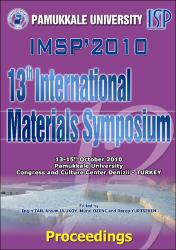Bortemperlenmiş küresel grafitli dökme demirlerin mikro-aşınma davranışlarının incelenmesi
Abstract
Bortemperleme; östenitlemenin bor tozu içerisinde yapılıp, takiben temperleme işleminin tuz banyosunda
yapıldığı iki aşamadan oluşan bir ısıl işlem yöntemidir. Bu çalışmada, Bortemperlenmiş küresel grafitli dökme demirin mikro-aşınma davranışına borlama süresinin ve temperleme sıcaklığının etkisi araştırılmıştır. 900 °C 'de 1, 3 ve 5 saat katı ortamda borlanan numuneler 250-300-350 ve 400 °C sıcaklıklarda 60 dakika tuz banyosunda temperleme işleminden sonra oda sıcaklığında soğutulmuş ve bol su ile yıkanarak kurutulmuştur. Bortemperlenmiş numuneler, oda sıcaklığında, 8 mm çapındaki WC-Co bilyeye karşı, 10N ve 20N yükler altında mikro-aşınma testlerine tabi tutulmuştur. Mikro-aşınma testi sonucunda oluşan aşınma iz çaplarından aşınma hacmi hesaplanmıştır. Daha sonra optik mikroskopta aşınma izleri ve metalografik olarak hazırlanan kesitlerden mikro yapılar incelenmiş ve fotoğrafları çekilmiştir. Bortemperleme işlemi ile küresel grafitli dökme demirin yüzey sertliği matris sertliğinin 6 katı kadar artış göstermiştir. Artan yüzey sertliği mikro-aşınma direncini arttırmıştır. Mikro-aşınma direncine bortemperleme şartlarının da etki ettiği gözlenmiştir. Artan borlama süresi ve azalan temperleme sıcaklığı ile mikro-aşınma direncinin arttığı belirlenmiştir. Boro-tempering; is a two stage process in which the specimens are first treated in Boron powder and tempered in
salt bath. In this study, the effect of boronizing time and austempering temperature on the behavior of microwear of boro-tempered ductile iron has been investigated. Specimens were boronized at 900 °C for 1h, 3h and 5h
and austempered at temperatures 250, 300, 350 and 400 °C for 60 minute then cooled down to room temperature
and cleaned by water to remove residues. Boro-tempered samples were wearing tested by against 8 mm diameter
WC-Co ball under the load of 10N and 20N. The wear volume of specimens was calculated by using diameter of
wear traces from micro-wear testing. In addition, the hardness of each specimen was also measured.
Microstructural characterization was carried out using optical microscope on wear traces and cross-sections of
specimens.
Boro-tempering process has increased the hardness of ductile iron up to six times of matrix hardness. Increased
surface hardness improved micro wear resistance of the surfaces. Boro-tempering conditions had an effect on
micro wear resistance behavior of the specimens. It was shown that high boronizing time and low tempering
temperatures increased micro wear resistance of the surfaces treated by boro-tempering.
Source
13th International Materials Symposium (IMSP’2010)Collections
- Bildiri Metinleri [14]



















